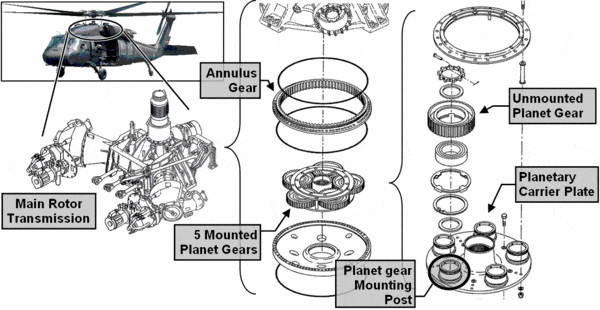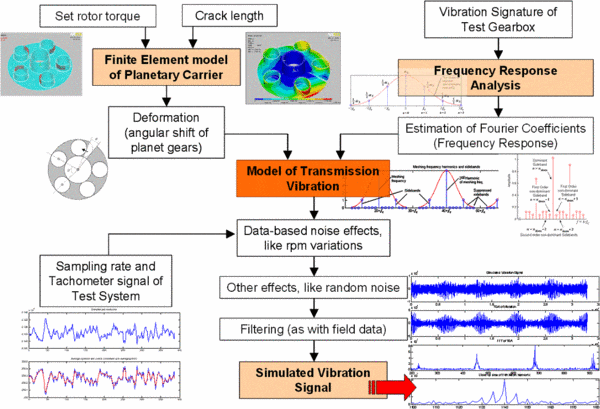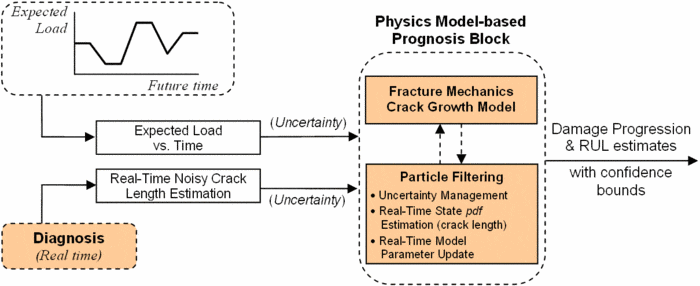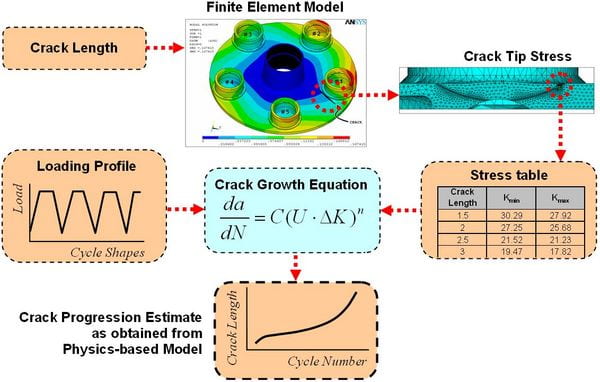Somewhat recently, instruments of a UH-60 “Black Hawk” helicopter of the U.S. Army indicated, while in flight, that there was a low oil pressure in the main mechanical transmission system of the aircraft. Once the aircraft was on ground and while attending to this warning, maintenance crew in charge of checking the lubrication pump and flow system discovered the presence of metal chips in the sump of the transmission gearbox. The presence of these chips was hindering adequate oil flow and was the cause of the instrumentation alarm. Obviously, the presence of these metal shavings was indicative of damage to mechanical parts, and a teardown of the transmission was carried out for further investigation.
Through this investigation, it was found that the planetary gear carrier plate –or “carrier plate” for short– of the main rotor transmission of the helicopter had developed a crack, which had gone undetected by the gearbox warning instrumentation system. The carrier plate is a critical component of the planetary gear transmission system that is used to transmit mechanical power from the engines to the main rotor blades of the helicopter. Some components of the planetary gear transmission are shown in the image below. Although it was determined that the metal shavings were not coming from the planetary carrier plate, but rather of certain alignment shims belonging to the gearbox, it was still deemed that the cause for the destruction of the shims was excessive vibration and stressing of the gearbox, which was in fact due to the crack of the plate.
Later on, a similar crack was found in another U.S. Army helicopter and in a U.S. Navy helicopter. Because the damaged part is a critical component of the aircraft, there is concern that, if unchecked, it may lead to the loss of the machine and thus the lives of people on board, so its appearance in multiple aircraft has become an issue of great concern to the U.S. Military and companies involved in the design and maintenance of these machines, including Sikorsky Aircraft (the principal manufacturer) and Northrop Grumman (providing avionics and other kinds of support). Even the Defense Advanced Research Projects Agency (DARPA) has sponsored research projects treating this issue, including the present work.
The crack, illustrated in the image below, developed on the root of one of the five planet gear mounting posts of the planetary carrier plate, which is a region of high stress in the part. Sahrmann (2004) carried out a comprehensive analysis of the crack origin and growth characteristics on the damaged part, while Keller and Grabill (2003), among others, have performed work in attempting to provide early detection techniques based on vibration changes.
The problems of detecting the crack in its early stages of development and predicting the time it will take for it to reach certain lengths are the application under study. The objective of this research is to develop a model-based health management architecture that is able to provide both model-based diagnosis and model-based prognosis.
Contents
Approach taken
Effort has been invested in attempting to identify distinct “building blocks” or modules over which part of the solution can be processed when attempting to design and implement an integrated, model-based health management architecture. The modularity aspect attempts to provide guidelines for designing each building block of the health management system in a modular fashion, i.e. so that modules can be easily combined without hindering their expected functionality. The objective of the modular approach is to ensure that this research effort is considered as that of a system of systems, or better said, a system of subsystems. The subsystems in question are many, and include, for example, the diagnostic and prognostic subsystems, the inner components of each of these two (like the physics-based models, the model adaptation routines, the data acquisition and preprocessing devices, etc.) or the operation regimes or assumption sets.
Results from this effort are the definition of blocks with particular functionality and the interconnection of these blocks to perform more and more complex tasks. The attempt at producing degrees of functionality is carried out in a modular, or block-by-block, manner, and the identification of individual functional and analysis modules makes it possible to perform work in the distinct fields of engineering that must be addressed to analyze a complex system like the helicopter transmission. These fields include Fracture Mechanics, Finite Element Analysis, Signal Processing, Systems Theory (including State Estimation, System Identification, etc.), Mechanics of Geared Systems and Mechanics of Vibration, and Probability and Random Process Analysis, among others.
The two main modules of the proposed health management architecture are the diagnosis module and the prognosis module. Other sub-modules exist within these, and they are treated below. Some of the key functional aspects that pertain to individual modules include:
- Vibration signature analysis and extraction of descriptive vibratory features in standard fashion, including the use of techniques for preprocessing and interpreting mechanical vibration signals (like time-synchronous averaging and frequency component analysis).
- Vibration signature characterization and modeling, based on developments by experts in the field of mechanical vibrations of geared systems (e.g. P.D. McFadden), including the analysis of vibration components, the effects of frequency modulation caused by the rotary motion, and the determination of vibration changes induced by the appearance of a fault. Modeling effort incorporates system-specific parameters and effects (e.g. noise).
- Finite Element Analysis (FEA), utilizing the widely-known ANSYS software package, of the system geometry under varying operating conditions to determine the mechanical effect caused by different extents of damage, including deformation patterns of the gearbox and structural stress distributions, especially at critical locations like fracture fronts.
- Use of an empirical model and considerations for characterizing crack growth, based on developments in the field of Fracture Mechanics, including adaptations of the famous Paris’ law of crack growth and load cycle shape considerations.
Performance of the integrated model-based diagnostic and prognostic architecture is evaluated by defining appropriate performance metrics and comparison with other means of performing diagnostics and prognostics, as opposed to the model-based method, is also being conducted to demonstrate the effectiveness and feasibility of the approach.
The Functional Module of System Diagnostics
For the case of the helicopter transmission we want to diagnose whether a crack exists in one of the components of the gearbox. Simulations using a model that replicates the helicopter transmission’s behavior can provide information on how vibration signals are expected to change when the crack is present, so that observing these changes in a helicopter will lead to the detection of the crack. Furthermore, simulation can also provide information about which vibration characteristics show a dependency relation with the crack progression, so that it becomes possible to also assess its length at a given instant.
The main goal of the diagnostics effort has been (1) to research the best practices in the design of model-based diagnostic systems and (2) to suggest an approach to designing a model-based diagnostic system that can be easily integrated with the prognostics system and into the proposed health management architecture for the helicopter transmission problem described earlier.
To provide validation of this effort, the technique presented earlier describing a generic approach to performing model-based diagnostics has been applied to the problem of diagnosing the development the fault mode considered (a crack in the planetary carrier plate) in the helicopter transmission. The image below shows how the modular modeling approach to diagnostics has been applied to this problem.
The image below shows how a reverse engineering approach has been used to successfully identify the crack length on the test of a helicopter transmission with crack in the planetary carrier plate.
The Functional Module of System Prognostics
For the case of the helicopter transmission, we want to know how much time it will take for a crack that has been deemed to be present to reach a critical length. Key considerations when making this kind of assessment are that (1) the crack growth rate depends on how the helicopter is used and (2) the initial conditions (starting crack length) are not exactly known.
The prognostics aspect of the helicopter transmission problem attempts to predict how the crack in the planetary carrier of the transmission gearbox will evolve given a specific load (or “usage”) profile. With this information, it is possible to make estimates of the Remaining Useful Life (RUL) or the Time to Failure (TTF) of the system. Because the task is complex, it has been carried out by a team of researchers, with different aspects requiring the participation of specialists in the corresponding disciplines. This team activity, in turn, provides validation and a means of refinement to the intent of establishing the model-based prognostics architecture sought. The image below illustrates how the effort was implemented, and it also highlights the three critical functional components of the prognosis task:
- Diagnosis
- Crack Growth Model
- Particle Filtering
The diagnosis block of this scheme fits the characteristics sought and described by the corresponding research in model-based diagnostics. It provides information about the estimated crack length at a given point in time as it is evaluated from feature values, all of which were previously extracted from vibration signals in real time. It can also provide the feature values to the particle filtering algorithm for improving the state estimation task and updating parameters of the crack growth model.
Because the prognostic process is inherently uncertain, the particle filtering block provides a way of evaluating and managing the uncertainty in the prediction of the remaining useful life of the system while at the same time providing for a means to adapt the crack growth model to improve its accuracy. Details on this aspect of research can be found in the section covering A Particle Filtering Framework for Prognosis.
The crack-growth model block provides information about the progression of the fault. In this area, a commercial software package for Finite Element Analysis (FEA) known as ANSYS, was used to determine the crack tip stress intensity factors of different crack sizes. With these values it was possible to estimate the corresponding crack growth rate as in the spirit of the famous crack growth law originally suggested by Paris and Erdogan (1963). The technique is represented in the image below.
References
Keller, J. and P. Grabill (2003). Vibration Monitoring of a UH-60A Main Transmission Planetary Carrier Fault. The American Helicopter Society 59th Annual Forum, Phoenix, AZ, May 6-8, 2003.
Sahrmann, G. J. (2004). Determination of the crack propagation life of a planetary gear carrier. 60th Annual Forum Proceedings, Baltimore, MD, Jun. 7-10 2004, American Helicopter Society.
Wu, B., A. Saxena, et al. (2004). Data Analysis and Feature Selection for Fault Diagnosis of Helicopter Planetary Gears. IEEE Autotestcon, San Antonio, TX, U.S.A.







